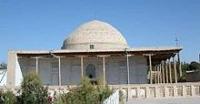You are here
Khalifa Hudoydod complex.

Classic tour of Uzbekistan.
"I erected a monument to myself, not made by hands,
There is no national path to it ”
Alexander Sergeevich Pushkin.
Last-minute tours in Uzbekistan.
The Khalifa Hudoydoid complex is one of the historical monuments of the 18th century of Bukhara. The population attributes the construction of a khanaka to a large Ishan of Khalif Hudo-idood, buried in the nearby Eshoni Imlo cemetery.
According to legend, he lived more than 200 years ago. There is an opinion that Khalifa Hudoydod came to Bukhara from Urgench. It is possible that Khalifa Hudoydod is one and the same person as Sheikh Khudoyberdy, whose biography called “Lutfi Buzurgh” is known in manuscripts. According to this source, Khudoyberdy originated from the Balkh region.
With a six-year-old child, he was brought to Bukhara, where then Muhammad-Rahim Mangyt ruled (1753 - 1758). Khudoyberdy enjoyed great respect from the rulers of Bukhara and died in extreme old age in 1841. The life story of Khudoyberdy was composed by his son in 1842 - 1843.
The Khalifa Hudoydoid Khanaka complex is located in the Old Town of Bukhara. Located in the block of the same name in Bukhara (Khalifa Hudoydod), inhabited mainly by saddlers, tanners and weavers. In addition to the khanaki, the complex included a hostel for blind readers of the Koran.
Supposedly built by Ishan Khalifa Hudoydoyd of Urgench. The mention of this character is only in the oral tradition. It is not excluded that he is identical to the sheikh Khudoyberdy, born in Balkh, who died in 1841, mentioned in his lifetime written sources.
Written sources contain confusion between the characters of Khalif Hudoydod and Sheikh Hudaydod Wali, but both of them are different people and lived at different times. The biographical data coincides in many ways with one of the popular legends, and both of the Sheikh’s names are accurate tracing notes (Hudoydód - Farsi, Khudoyberdy - Turkic).
There is another legend, according to which, the lifetime of Khalif Hudoydod coincides with the time of the rule of Abdulaziz Khan (1645 - 1680). According to this legend, Abdulaziz Khan was a muridom of Khalif Hudoydod, consisting simultaneously of a muridom and another Bukhara saint - Mavlono Sharif (XVII century).
Both elders fought for a long time for the Khan, who hesitated which of them would prefer. Hanaka is a constructive type of mosque, which, in addition to prayers, also served as a place where, on Fridays, there were loud religious celebrations of zikr.
When the khanaka was a hostel for the blind - the readers of the Koran.
Enlightener:
VG Saakov "History of Bukhara". Shark Publishing House, 1996. “Bukhara. Masterpieces of Central Asia. Historical guide to Bukhara. year 2012. "Bukhoro Bukhara Bukhara" In Uzbek, English and Russian. Publishing House "Uzbekistan", Tashkent 2000. Muhammad Narshahi. History of Bukhara. Tashkent. 1897 (translated by N. Lykoshin). V.G. Saakov Architectural masterpieces of Bukhara. Bukhara regional society "Kitabhon" Uz SSR, Rovno 1991, Robert Almeyev. The history of ancient Bukhara. (Edited by Academician of the Academy of Sciences of the Republic of Uzbekistan Rtveladze E.V.)
Photos by
Alexander Petrov.







